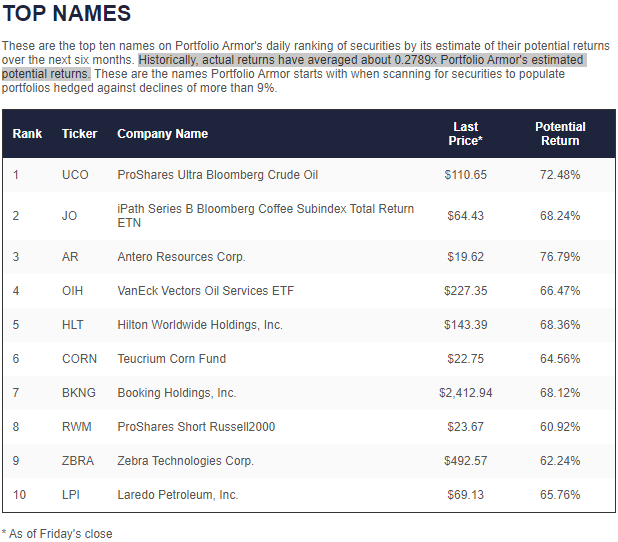Higher Food Prices And Shortages?
Our system has been betting on higher food prices since earlier this year, and of course the war in Ukraine has put upward pressure on food an energy. But now one of our Twitter correspondents warns we may have food shortages in America as well. Let's start with the case for higher prices, then consider his warning of shortages and what to do about them.
Betting On Higher Food And Energy Prices
A month before Russia's invasion of Ukraine, our system's top names had shifted to an energy and food focus.
Biden's welcome to Pittsburgh was a bridge collapse. Fittingly symbolic of our broader collapse. $CORN $UCO $OIH $RWM https://t.co/H8R2hMWZbi
— Portfolio Armor (@PortfolioArmor) January 29, 2022
In that post, we noted we had two oil E&P stocks (Laredo Petroleum (LPI) and Antero Resources (AR)), two oil ETFs (ProShares Ultra Bloomberg Crude Oil (UCO) and VanEck Vectors Oil Services (OIH)), and a coffee ETN (iPath Series B Bloomberg Subindex Total Return (JO)) and a corn ETF (Teucrium Corn Fund (CORN)) in our top ten names.

Screen capture via the Portfolio Armor on 1/28/2022.
Since then, the energy and corn names have ripped higher (though coffee has cooled off a bit).
Of course, Russia's invasion of Ukraine has played a role here. In addition to being one of the world's top exporters of wheat (along with Ukraine), Russia is also one of the top exporters of agricultural inputs such as oil, natural gas, and fertilizer. The war, plus the sanctions regime in response to it, have raised food and energy prices and raised the prospect of food shortages in countries such as Egypt, which are dependent on wheat imports. America, as an agricultural superpower, seemed less likely to suffer food shortages.
A String Of Disasters at Food Processing Plants and Warehouses
Our correspondent Ben Braddock brought up another risk factor: a string of disasters at food production plants and warehouses, mainly in the U.S.
— Dr. Benjamin Braddock (@GraduatedBen) April 20, 2022
— Dr. Benjamin Braddock (@GraduatedBen) April 20, 2022
— Dr. Benjamin Braddock (@GraduatedBen) April 20, 2022
Not just the US either - this was last month in Taiwan at a grocery logistics center, absolutely massive fire https://t.co/0qGtQeukdn
— Dr. Benjamin Braddock (@GraduatedBen) April 20, 2022
Meanwhile, 27 million chickens and turkeys - and counting - are being culled because of bird flu https://t.co/UgU7qDQdQB
— Dr. Benjamin Braddock (@GraduatedBen) April 20, 2022
There’s more https://t.co/EoxglZTYmp
— Dr. Benjamin Braddock (@GraduatedBen) April 20, 2022
Two months ago https://t.co/a8lCSwjxwT
— Dr. Benjamin Braddock (@GraduatedBen) April 21, 2022
Should We Be Worried About This?
One respondent says we shouldn't.
Warehouse fires are nothing new. They happen every year. You just have not been paying attention. The actual scale of the loss is miniscule compared to the size of the actual food supply.
— Just Some Guy Man (@Teach_2_Win) April 20, 2022
In the U.S. there were approximately 1,240 warehouse fires per year between 2009 and 2013, with annual property damages of around $155 million. This represents a reduction in the number of fires over a 30-year observation period, from 4,700 to around 1,200 per year.
— Just Some Guy Man (@Teach_2_Win) April 20, 2022
Another commenter draws a comparison to the panic about black churches burning down a few years ago.
Remember the “black churches are burning all over the South” media panic in the 1990s? Turned out people didn’t understand that there is a vast number of churches in the country, and a lot of them catch fire, especially in rural areas.
— Citizen of Omni-America (@ghostofalbertm1) April 21, 2022
In Case There Will Be Shortages
Twitter user "Remnant" offers some suggestions just in case we do have food shortages.
If you haven't already, go to the store and, at the very least, buy a big bag of rice and some dry beans. Canned anything is good too. Go as calorie-dense as possible.
— 🔺ʀᴇᴍɴᴀɴᴛ. (@remnantposting) April 21, 2022
Ideally, you portion the stuff out and vacuum seal it, or seal in mylar bags with oxygen absorbers, then put those in your hard containers. Something like this:https://t.co/fCHPrRIZJD
— 🔺ʀᴇᴍɴᴀɴᴛ. (@remnantposting) April 21, 2022
Plan for 2,000/cal per person per day. You won't actually want to eat that much, as you can survive on less to stretch the food, but it gives you headroom. The more you can get the better, minding budget and storage space limitations. Shoot for at least a couple of weeks' worth.
— 🔺ʀᴇᴍɴᴀɴᴛ. (@remnantposting) April 21, 2022
Also, MAKE SURE you have some way to purify water if you have to. If you can afford it, get some bottled water to hold onto as a last resort. Get iodine tablets, and ideally a gravity-fed filter as well. The filter and tablets are great because they require no energy.
— 🔺ʀᴇᴍɴᴀɴᴛ. (@remnantposting) April 21, 2022
These seem like reasonable, and fairly inexpensive precautions.
© 2025 Benzinga.com. Benzinga does not provide investment advice. All rights reserved.
Trade confidently with insights and alerts from analyst ratings, free reports and breaking news that affects the stocks you care about.